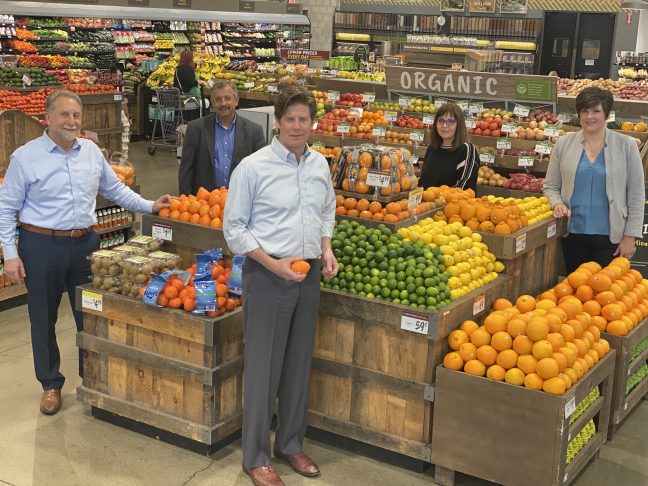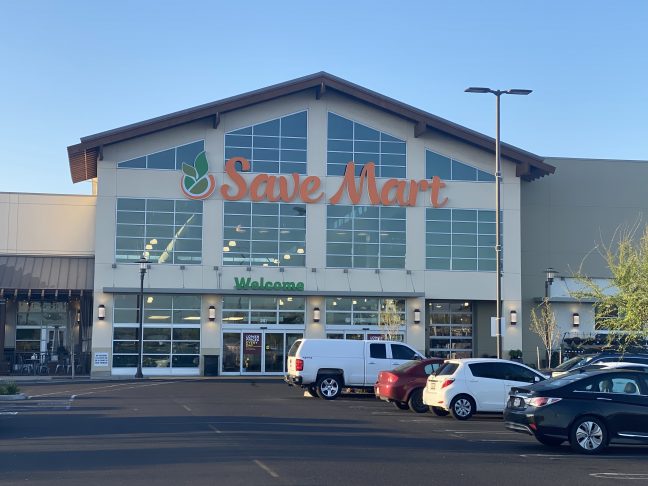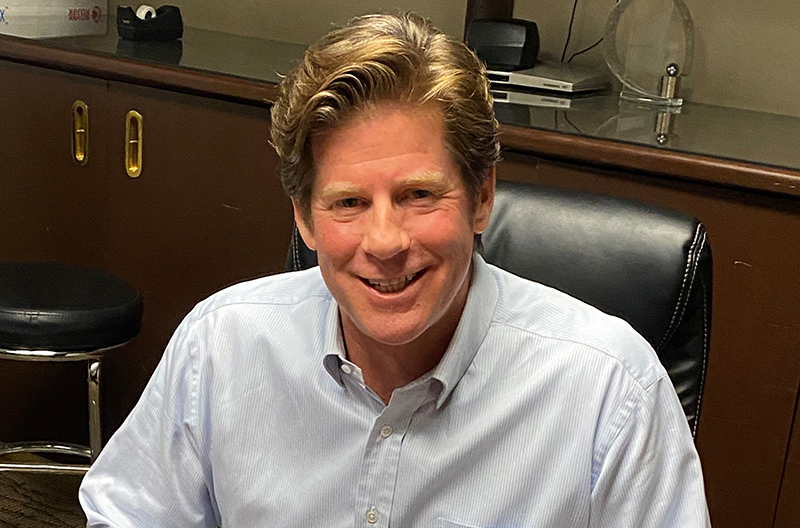The grocery industry was not on The Save Mart Companies CEO Chris McGarry’s radar when planning his career. The New Jersey native attended Seton Hall University and earned three degrees: a bachelor’s in history, an MBA in finance and a law degree.
“If you had asked me 30 years ago if I’d have a career in grocery, I would have questioned your sanity for sure,” McGarry told The Shelby Report’s Bob Reeves. Save Mart has been named Shelby’s 2022 West Retailer of the Year.
McGarry said when he talks to students in the food industry program at the University of Southern California and they tell him they are studying law, he points out that the food industry needs lawyers.
McGarry started out in private practice with a midsize firm in New York and New Jersey. He said some of his clients involved supermarket chains and he represented the Grand Union company, “an old-time, now defunct regional chain.” That was his first foray into the grocery business, when the general counsel at Grand Union hired him as assistant general counsel and also to run the real estate department.
While he was hesitant at first, McGarry said he accepted the job and continued there for three or four years until the company went out of business. He then got a job as general counsel for a third-party logistics company, which supplied a lot of grocery stores.
This kept him close to the industry but on the supply chain side. When the company eventually was acquired by DHL, he “parted ways” in 2005. Early the next year, he was hired as general counsel by A&P Supermarkets.
“That’s where my transformation professionally began to occur, as I moved away from doing legal work for the company and undertaking a variety of different responsibilities,” McGarry said.
As general counsel, he began hiring for the legal department and was looking for a different kind of lawyer, “folks that had a business acumen and were very much customer service oriented,” he said. “I was intent on changing the personality of the legal team as being really value add, great partners, driving the business. And what began to happen is, my lawyers were being poached by the business teams to take on business roles in merchandising, operations, risk management, these kinds of things.”
He’s always felt very strongly about “developing people, hiring the right people and making sure that they’re engaged, that they’re challenged, that they’re developed.”
“I always believed in building that relationship with the store level. I worked my way through school…I had developed a deep and abiding respect for hard-working people. That never left me, and I found that there were opportunities for me to help people in a way that helped the business in grocery. That’s something that I firmly believe in even today. It’s what drew me to The Save Mart Companies.”
McGarry joined The Save Mart Companies in 2017. He became chief administrative officer that same year and was promoted to CEO in 2021.

East to West transition
McGarry said working in the grocery industry on the West Coast has some differences.
“You really need to be very creative and innovative in how you’re maximizing the use of space – you don’t have as much space,” he said. “And then, think about what a strawberry has to go through in order to get to a store in the greater tri-state New York area. I have a profound appreciation for what we have here, being in the breadbasket, the heartland for all the agriculture.
“I love California. I love the distinctions between the San Francisco Bay Area and the Central Valley. I love the symmetry of the agricultural fields. It’s very peaceful; it’s very calming. There’s something rhythmic about it,” McGarry said.
He noted the distinctions between the Central Valley, Northern California, Southern California and the Bay Area.
“That’s something that we’re really sharpening our focus on right now in the Bay Area is reflecting the ethnic diversity and then also curating the stores to be more of a store of the neighborhood,” he said. “The Bay Area, in particular, reminds me of a lot of communities that we had in New Jersey and in New York, so that’s the only place where I draw the similarities. But the Central Valley – it’s all about families, the connection to agriculture, center of the plate, a branded experience.
“You can go into a Save Mart store just about anywhere in the Central Valley, and you’ll have a similar experience. In the Bay Area, it’s much different. And then even though FoodMaxx straddles both of those, that is still a branded experience for us in terms of meeting the needs of customers who are really under a lot of pressure with a food budget. In the East Coast, you really need to be very creative and innovative.”
FoodMaxx was in no man’s land
When he joined The Save Mart Companies, McGarry described the FoodMaxx banner as “languishing in a little bit of no man’s land.”
“It was calling itself a true value proposition, but the reality was we were neither communicating clearly that way, we weren’t priced that way, we weren’t merchandised that way and operationally we were confused. We didn’t know whether were trying to optimize operations in order to drive efficiency and cost savings that would flow to the bottom line, or whether we were focused on sales and margin.”
He said that confusion was some of the outgrowth from the Great Recession in 2010, when FoodMaxx was a clear value proposition. As people traded down, the company expanded the assortment and offerings.
“People were flocking to FoodMaxx. But the problem was that as the economy recovered and folks began to resume their ordinary shopping behavior. We then kind of hung on to what the reality of FoodMaxx had become in 2010-11,” he said. “And through that process, we were antagonizing some of the value shoppers who saw better options [elsewhere]. At the same time, we weren’t offering the kind of spec and quality…so we’re in this no man’s land.”
Just before the COVID-19 pandemic hit, McGarry said The Save Mart Companies decided to give the FoodMaxx banner some “standalone attention.”
“As a consequence, we’ve re-established our market approach there, which is we’re focused on the tonnage, on item movement and not so much sales and margin. Then you see in the stores, we’ve got pallet positions, case packing. The idea is that we drive these operational efficiencies, that’s where the profitability comes from,” he said.
“And this has been taking off. We’ve been experiencing double-digit comps…and we’re only about halfway through the banner. We’re going to complete the capital program to restore steel, huge pallet positions, a great wall of value, those kinds of things.”
FoodMaxx customers are among the company’s most discerning.
“They’re very smart shoppers,” McGarry said. “You can’t do a bait and switch, you can’t lower the price on critical items and elevate background items and think they’re not going to notice. They get it, and they know what they can buy, for what and where.”
He said another change in the company is to ensure that it is communicating in “an authentic, genuine, honest way with this customer,” including what FoodMaxx is doing in order to deliver savings for them.
“All of these are so important, but it’s kind of our North Star for FoodMaxx,” he said.

Save Mart different by design
With the Save Mart stores, McGarry said the company decided to “play to our strengths.”
“We want to be true to ourselves,” he added. “We don’t want to have to become a different company to evolve our brands, because I think that’s a recipe for disaster.”
Looking at the next generation of the Save Mart store, he points to locations in Modesto and Redding as examples.
As for the physical environment, “We were trying to communicate that connectivity of the Central Valley to the agricultural sector, ‘Valley Proud,’ and you see it…[there’s] heavy emphasis on agriculture and fresh, and in a way that we haven’t done before – but in a very nice store.”
He noted the exposed concrete floors, cinderblock walls and “the entrails” of the HVAC system.
“That is to communicate a simplicity and authenticity that there’s no polish here that we’re trying to use to distract the customer away from quality and quality of value,” he said. “Even with the physical environment, we want to make sure we are looking our customers in the eye and communicating in the right way with them.”
He also noted the “programmatic attributes” and innovation, which include: an open-air grill; grilling and cooking to order; custom-made sausage; agua fresca; the fruit and vegetable production area; and a sit-down restaurant, which becomes a point of theater.
“We wanted to create different points of entertainment throughout the store, but in an authentic way,” he said in reference to Tipping Point, a fast-casual restaurant located in the store.”
“Tri-tip is Central Valley. It’s a restaurant, but we don’t have an expansive menu. But I can guarantee that you’re going to get the best tri-tip…that you can get in a 50-mile radius. And similarly, as we go through the store, that’s what we’re trying to communicate. We have an entertainment destination, but it’s not ostentatious. It’s really focusing on how can we serve the customer; it’s tailored to the needs of the customer.”
Another area of importance for the Save Mart banner is that it maintains its pricing. McGarry said that is something that was established across the enterprise in 2018.
“We’ve been careful not to be perceived as trying to pull a fast one on a customer,” he said. “We index on matching items. We know where we index against all the competition and the price zones that we operate. That is an approach that we’ve taken between Save Mart and Lucky California.”
Lucky provides entertainment
As for the Lucky California banner, it has curated a lot of entertainment for the particular tastes of the Bay Area shoppers. Although there is not a sit-down restaurant, customers can go and get a smoothie or glass of wine while shopping. Prepared foods include a hummus bar, ramen, burritos – “all of these are foods that folks want in the Bay Area.”
McGarry said they are creating entertainment, prepared foods, meal solutions and entertaining solutions in the Lucky stores.
“Just because someone wants to have healthy options and organics, and an entertaining experience, they don’t have to pay through the nose for it. That was our design there, to create that kind of an experience for everyone. And so far, that store is really resonating with the community.”
Drawing a parallel between the Save Mart and Lucky banners, McGarry said he believes Save Mart is more of a branded experience. The company is looking for additional locations and to “tweak” the next generation concept.
He added that the company wants to continue to evolve with Lucky California. “We’ve really struck something here.”
“We don’t really have too much deferred maintenance or stores that are in need of investment,” he explained. “It’s really how do we export some of the programs that we see are resonating with customers in the Bay Area into our existing fleet? And at the same time, we’re searching out these incremental opportunities wherever they may exist.”
Retail today is highly competitive and stores have to be differentiated and execute flawlessly, according to McGarry. Going forward, a sense of entertainment and theater will draw customers, similar to a restaurant.
“There’s consistent quality, reasonable price and you’re always made to feel welcome,” he said. “And that’s grocery retail.”
For more information, visit thesavemartcompanies.com.
To read the full Retailer of the Year flip book on The Save Mart Companies by The Shelby Report, click here.

